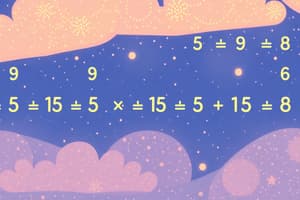Podcast
Questions and Answers
What pattern is recognized in the sequence 2, 4, 8, 16?
What pattern is recognized in the sequence 2, 4, 8, 16?
- Addition of 2
- Subtraction of 2
- Multiplication by 2 (correct)
- Division by 2
When subtracting 25 from 58, what is the difference?
When subtracting 25 from 58, what is the difference?
- 32 (correct)
- 24
- 28
- 34
Which of the following represents the multiplication of 4 and 3 using an array?
Which of the following represents the multiplication of 4 and 3 using an array?
- A column with 7 rows
- 4 rows of 3 columns (correct)
- 3 rows of 4 columns (correct)
- A single row of 12
What is the area of a rectangle with a length of 5 cm and a width of 3 cm?
What is the area of a rectangle with a length of 5 cm and a width of 3 cm?
Which shape is symmetrical if folded vertically down the middle?
Which shape is symmetrical if folded vertically down the middle?
What is the missing addend in the equation 15 + ? = 20?
What is the missing addend in the equation 15 + ? = 20?
Which is a method of organizing data effectively when presenting results?
Which is a method of organizing data effectively when presenting results?
Which operation is used to find the total when calculating how many packages of 5 cookies there are in 30 cookies?
Which operation is used to find the total when calculating how many packages of 5 cookies there are in 30 cookies?
Flashcards
Number Patterns
Number Patterns
Recognizing and extending sequences of numbers based on a rule.
Addition and Subtraction Facts
Addition and Subtraction Facts
Knowing quickly the sums and differences to 20.
Multiplication
Multiplication
Repeated addition of the same number.
Division
Division
Signup and view all the flashcards
2D Shapes
2D Shapes
Signup and view all the flashcards
Symmetry
Symmetry
Signup and view all the flashcards
Perimeter
Perimeter
Signup and view all the flashcards
Data Handling
Data Handling
Signup and view all the flashcards
Study Notes
Number Patterns
- Understanding number sequences and identifying patterns
- Recognizing increasing and decreasing patterns
- Extending number sequences by applying the identified pattern
- Using number lines to visualize patterns
- Identifying and describing rules of number patterns
- Creating number patterns using various operations (addition, subtraction).
Addition and Subtraction
- Fluency with addition and subtraction facts to 20
- Adding and subtracting two-digit numbers (using different strategies and methods).
- Addition and subtraction word problems involving everyday contexts
- Solving problems involving addition and subtraction using objects, diagrams, and strategies.
- Estimating sums and differences
- Understanding place value to aid in addition and subtraction
- Using inverse relationships (subtraction to find missing addends or addition to find missing minuends/subtrahends)
Multiplication and Division
- Understanding multiplication as repeated addition and division as repeated subtraction.
- Developing fact fluency for multiplication and division facts up to 3 × 5
- Representing multiplication and division using arrays, equal groups, and number lines.
- Solving word problems involving multiplication and division, applying context and strategies.
- Recognizing and interpreting multiplication and division symbols.
- Applying multiplication and division to solve real-world situations involving groups or sharing.
- Introducing the idea of factors and multiples, though formal study isn't required.
Geometry and Measurement
- Identifying and describing 2D shapes (e.g., triangles, squares, rectangles, circles, pentagons, hexagons).
- Recognizing symmetry in 2D shapes (horizontal, vertical, rotational).
- Measuring lengths using standard units (centimetres, and metres).
- Using a ruler and other measuring tools effectively.
- Recognizing and describing properties of 3D shapes (e.g., cubes, rectangular prisms, cones, cylinders).
- Understanding and applying concepts of perimeter (calculating the distance around a shape).
- Understanding and applying concepts of area (counting squares to calculate area of shapes).
Data Handling
- Gathering, representing and interpreting data
- Organizing data using simple tables and picture graphs
- Creating and interpreting simple bar graphs, pictographs, and line graphs.
- Interpreting data to answer questions by identifying patterns, trends, and particular values.
- Reading data presented in various graphical representations.
- Forming simple conclusions based on patterns in data, and discussing their meaning.
- Identifying the data, the question, and the conclusion involved in solving a problem with data.
Studying That Suits You
Use AI to generate personalized quizzes and flashcards to suit your learning preferences.




